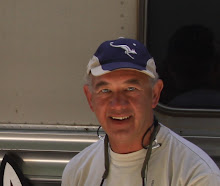 The lush vegetation of Rwanda - a thriving country with a dreadful past
The lush vegetation of Rwanda - a thriving country with a dreadful pastIt was not only the language that changed when we ventured south into Rwanda. Crossing the border also meant driving on the right and not the left as we had in Kenya and Uganda. The clocks went back an hour too. The landscape became very lush and green. At regular intervals along the road there were fields full of workers picking the precious coffee beans. Often the workers would wave to me and instantly I began to sense that this was a far friendlier place than Uganda has sometimes been. But it was also a place with a very dark recent past.
Rwanda was colonised by the Germans in 1895. After World War One power was given over to the Belgians. They decided to divide the population into Tutsi and Hutu, with power being given to the minority Tutsi.
At the time there was much study of the African races and the white anthropologists concluded that having larger skulls and paler skins, the Tutsis were far closer to the Caucasian races and therefore superior. This led to decades of tension between the two tribes as the minority suppressed the majority and hatreds grew.
These tensions eventually erupted in April 1994 when the Hutus rose against the Tutsis and over the course of 3 months over 1 million Tutsis were murdered.
The full story of what led to the genocide is well documented elsewhere, in far more detail than I have painted here.
It was an atrocity on a par with the holocaust, and yet it is within the living memory of most people reading this. It is certainly an event fresh in the memory of the people of Rwanda and its legacy hangs over the country like a rain cloud.
There is a palpable sense of the need to be forgiven and nowhere is this more evident than at our first stop in Rwanda, at the Genocide Memorial in the capital Kigali.
At the heart of the memorial is a large modern building that tells the story of the genocide. Entrance is free.
The visit was harrowing throughout. It starts by providing the background to what occurred, before giving an overview of the violence itself. The story is told through artefacts, documents, pictures and text. Touch screen TVs play the dreadful accounts of the survivors. The story of these people is always the same - loved ones butchered and brutalised, often by people who had previously been friends, neighbours and work colleagues. A young woman, who lost her entire family, describes how 5% of the Hutus tried to help, 5% were indifferent and the remainder were caught up in an orgy of blood lust and violence. It serves as a gruesome reminder of just how easily the thin veneer of civilisation can be cast off.
A large, round room contained hundreds if not thousands of photographs of people who were killed. They were just the ordinary snapshots we all keep somewhere of loved ones in happy situations.
Another room contained the skulls, bones and artefacts of some of the dead. Personally, I found this area to be unnecessary. The enormity of what happened only 15 years ago was sinking in and it was as if the point was now being hammered home just to make sure. The final emotional twist came when I went upstairs.
Here there were pictures of children aged between 9 months and 10 years, who had been killed. The pictures were all of the children in life and underneath each picture was a brief biography - what they liked to eat, what they liked to do, what they were like and how they died. It was as if the details had been taken from a school report.
Most of the children had died from machete wounds to the head. Sisters aged 6 and 7 died together when a grenade was thrown into their shower.
Sorrow now became tinged with disbelief. An inability to comprehend how such violence could be wreaked upon these innocent lives.
It was proper that our journey to Rwanda should begin at the Genocide Memorial. But it coloured the remainder of our stay. The people I saw and met were just like anywhere else on our journey. At the back of my mind though there was always the question of what these people had done during those awful 100 days of killing.
My impression of Rwanda was of a thriving country. Kigali is a modern city by African standards and I much preferred it to Nairobi and Kampala. But woven into its fabric are shame and guilt that will take many generations to fade.


Thanks for posting and writing compassionately on a difficult, disturbing and emotional subject. I recall a BBC news item during the troubles late at night and watching a soldier, shot through a long lens from the safety of a hillside, butcher two women carrying water on a lonely country road with a machette. It's an image that remains with me today and like you the hatred and violence against individuals and humanity in this civil war is both bewildering and inexplicable. The stuff of nightmares.
ReplyDeleteRLS